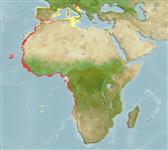>
Eupercaria/misc (Various families in series Eupercaria) >
Haemulidae (Grunts) > Plectorhinchinae
Etymology: Plectorhinchus: Greek, plektos = plaited + Greek, rhyngchos = snout (Ref. 45335).
More on author: Guichenot.
Environment: milieu / climate zone / Tiefenbereich / distribution range
Ökologie
seewasser demersal; tiefenbereich 10 - 180 m (Ref. 27000). Subtropical; 45°N - 22°S, 25°W - 20°E
Eastern Atlantic: Spain and Portugal to Henties Bay, Namibia (Ref. 11228). Also from the western Mediterranean Sea (Ref. 231) and the Canary Islands (Ref. 5535). Records in eastern Mediterranean are questionable (Ref. 57855, Ref. 113897).
Size / Gewicht / Alter
Geschlechtsreife: Lm ? range ? - ? cm
Max length : 80.0 cm SL Männchen/unbestimmt; (Ref. 5535); common length : 60.0 cm SL Männchen/unbestimmt; (Ref. 5535); max. veröff. Gewicht: 7.9 kg (Ref. 40637)
Rückenflossenstacheln (insgesamt) : 10 - 13; Rückenflossenweichstrahlen (insgesamt) : 17 - 20. Grey violet color, abdomen light (Ref. 5377).
Body shape (shape guide): fusiform / normal.
Inhabits sandy and muddy bottoms. Feeds on zoobenthos and zooplankton (Ref. 5535). Minimum depth reported from Ref. 5535.
Life cycle and mating behavior
Geschlechtsreife | Fortpflanzung | Ablaichen | Eier | Fecundity | Larven
Oviparous, distinct pairing during breeding (Ref. 205).
Ben-Tuvia, A. and R. McKay, 1986. Haemulidae. p. 858-864. In P.J.P. Whitehead, M.-L. Bauchot, J.-C. Hureau, J. Nielsen and E. Tortonese (eds.) Fishes of the north-eastern Atlantic and the Mediterranean. volume 2. UNESCO, Paris. (Ref. 5535)
IUCN Rote Liste Status (Ref. 130435: Version 2025-1)
Bedrohung für Menschen
Harmless
Nutzung durch Menschen
Fischereien: kommerziell
Tools
Zusatzinformationen
Download XML
Internet Quellen
Estimates based on models
Preferred temperature (Ref.
123201): 16.1 - 24.4, mean 19 °C (based on 81 cells).
Phylogenetic diversity index (Ref.
82804): PD
50 = 0.5000 [Uniqueness, from 0.5 = low to 2.0 = high].
Bayesian length-weight: a=0.01318 (0.00855 - 0.02033), b=3.04 (2.91 - 3.17), in cm total length, based on LWR estimates for this species & Genus-body shape (Ref.
93245).
Trophic level (Ref.
69278): 3.5 ±0.52 se; based on food items.
Generation time: 6.2 ( na - na) years. Estimated as median ln(3)/K based on 1
growth studies.
Widerstandsfähigkeit (Ref.
120179): mittel, Verdopplung der Population dauert 1,4 - 4,4 Jahre. (K=0.18;).
Prior r = 0.53, 95% CL = 0.35 - 0.80, Based on 1 data-limited stock assessment.
Fishing Vulnerability (Ref.
59153): Moderate to high vulnerability (54 of 100).
🛈
Climate Vulnerability (Ref.
125649): Moderate vulnerability (45 of 100).
🛈
Nutrients (Ref.
124155): Calcium = 50.5 [12.0, 100.4] mg/100g; Iron = 0.928 [0.485, 1.769] mg/100g; Protein = 19.3 [17.4, 21.0] %; Omega3 = 0.331 [0.182, 0.545] g/100g; Selenium = 35.6 [19.5, 66.7] μg/100g; VitaminA = 9.02 [3.64, 21.40] μg/100g; Zinc = 0.636 [0.453, 0.909] mg/100g (wet weight); based on
nutrient studies.
